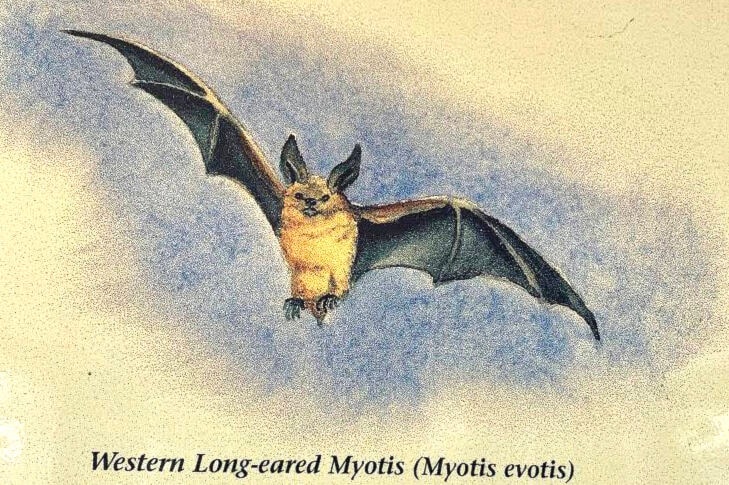Roseanne Van Ee
The OkanaganÔÇÖs Nature Nut
The OkanaganÔÇÖs low to mid elevation ecosystems have the greatest variety and population of bats in all of Canada because of its warm climate and diversity of terrain. Our warm summer nights allow young bats to fatten up while insect prey is abundant before hibernation.
Of the 15 B.C. bat species, these 14 species live in the Okanagan (*endangered or threatened):
┬À big brown bat (rptesicus fuscus)
┬À hoary bat (lasiurus cinereus)
┬À silver-haired bat (lasionycteris noctivagans)
┬À Yuma myotis (myotis yumanensis)
┬À Californian myotis (myotis californicus)
┬À little brown myotis (myotis lucifugus)
┬À long-legged myotis (myotis volans)
┬À TownsendÔÇÖs big-eared bat * (corynorhinus townsendii a.k.a. plecotus townsendii)
┬À western long-eared myotis (myotis evotis)
┬À fringed myotis * (myotis thysanodes)
┬À western red bat (lasiurus blossevillii)
┬À spotted bat * (euderma maculatum)
┬À western small-footed myotis (myotis ciliolabrum)
┬À pallid bat * (antrozous pallidus)
Myotis means mouse-eared and these are our smaller, brown fur bats.
Bats are ecologically important for controlling insect populations. Yet despite their importance to our ecosystems, thereÔÇÖs more misinformation than fact, and more fear than respect for these fascinating night guardians. We need to appreciate them.
HereÔÇÖs some amazing bat facts:
- Even though bats look like flying mice, they are more closely related to humans than they are to rodents.
- Bats are the longest living (20-40 years) and slowest reproducing small mammals on Earth.
- Like humans, young bats loose their baby, or milk, teeth before their adult teeth grow in.
- Bats are very clean animals, and groom themselves almost constantly (when not eating or sleeping).
- Our bats have small eyes but are not blind. Their eyesight is good and they have excellent echolocation so they do not become entangled in human hair.
- A single little brown myotis can eat up to 600 mosquitoes/hour. And a nursing mother can eat more than her body weight nightly (up to 4,500 insects).
- Little brown myotis heart rate reduces to 10 beats/minute (from 100-200 beats/min resting or 1,000 beats/min flying) and can take one breath/hr while hibernating.
- Our bats can squeeze into tiny crevices like behind pieces of bark to roost.
- Bat droppings (guano) in caves support whole ecosystems of unique organisms including bacteria useful in detoxifying wastes, improving detergents, and producing gasohol and antibiotics.
- The pallid bat is immune to the stings of the scorpions and centipedes upon which it feeds.
- Moths sometimes plummet to the ground when they hear the echolocation calls of bats in an attempt to escape.
If youÔÇÖre curious about bats read Bats of British Columbia by David Nagorsen et al, 2022. This totally updated book is full of interesting information with numerous amazing colour photos throughout of bats close up and in action, and describes each bat species. Our library has it.
If you have bats check out for details on safely removing bats from your house and properly placing bat boxes for them to move into. TheyÔÇÖll keep mosquitoes down in your yard. Bat houses provide places for roosting and raising young, replacing the dwindling natural sites available to them. Installing bat houses can help build valuable bat species populations that eat crop and forest damaging insects.
Watching bats
On hot summer days: roosting under eaves or bridges, in crevices in cliffs, trees, buildings, in umbrellas and shrubs.
At dusk: catching insects above lakes, ponds, large puddles, slow moving creeks and rivers.
Leaving bat boxes and maternity colonies alone.
Major threats to bats
Habitat destruction - especially forests, wetlands and wildlife trees (snags).
Vehicle collisions, domestic cats, pesticides, night sound pollution (road traffic, mining, etc), bat exterminations, wind turbines, solid mine closures, disease (white-nose syndrome), and now climate change.
Roseanne Van Ee enthusiastically shares her knowledge of the outdoors to help readers experience and enjoy nature. Follow her on Facebook.
READ MORE:
READ MORE:
newsroom@vernonmorningstar.com
Like us on and follow us on



